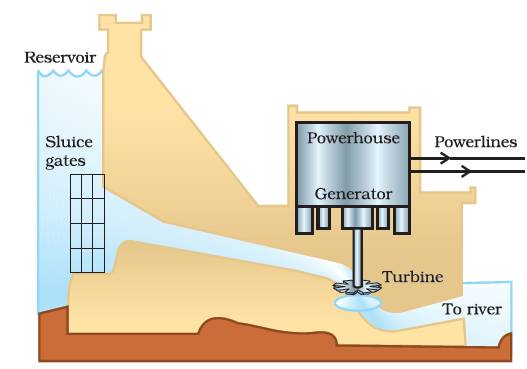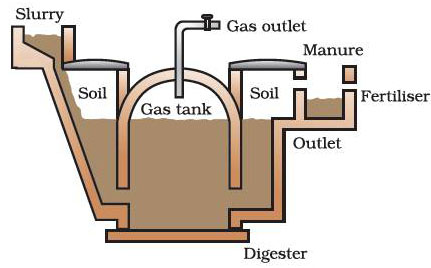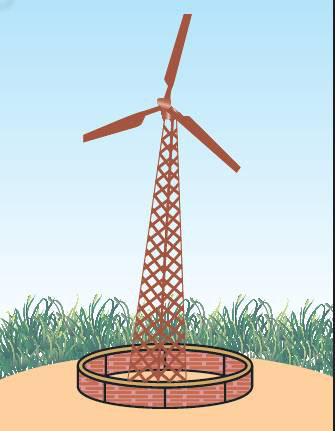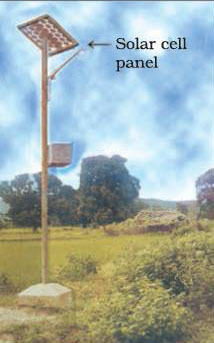Energy comes in different forms and one form can be converted to another.
If we light a candle, the process is highly exothermic so that the chemical energy in the wax is converted to heat energy and light energy on burning.
The muscular energy for carrying out physical work, electrical energy for running various appliances, chemical energy for cooking food or running a vehicle all come from some source.
The exploitation of coal as a source of energy made the industrial revolution possible. Increasing industrialization has led to a better quality of life all over the world. It has also caused the global demand for energy to grow at a tremendous rate.
The growing demand for energy was largely met by the fossil fuels – coal and petroleum. Our technologies were also developed for using these energy sources.
The fossil fuels are non-renewable sources of energy, so we need to conserve them. If we were to continue consuming these sources at such alarming rates, we would soon run out of energy! The oxides of carbon, nitrogen and sulphur that are released on burning fossil fuels are acidic oxides. These lead to acid rain which affects our water and soil resources.
The pollution caused by burning fossil fuels can be somewhat reduced by increasing the efficiency of the combustion process and using various techniques to reduce the escape of harmful gases and ashes into the surroundings.

Here we learn, How turbine generating electricity. The simplest turbines have one moving part, a rotor-blade assembly. The moving fluid acts on the blades to spin them and impart energy to the rotor. Thus, we see that basically we need to move the fan, the rotor blade, with speed which would turn the shaft of the dynamo and convert the mechanical energy into electrical energy — the form of energy which has become a necessity in today's scenario.
The fossil fuels are burnt every day in power stations to heat up water to produce steam which further runs the turbine to generate electricity. The transmission of electricity is more efficient than transporting coal or petroleum over the same distance. Therefore, many thermal power plants are set up near coal or oil fields. The term thermal power plant is used since fuel is burnt to produce heat energy which is converted into electrical energy.
Hydro power plants convert the potential energy of falling water into electricity. Since there are very few water-falls which could be used as a source of potential energy, hydro power plants are associated with dams. In the last century, a large number of dams were built all over the world.

In order to produce hydel electricity, high-rise dams are constructed on the river to obstruct the flow of water and thereby collect water in larger reservoirs. The water level rises and in this process the kinetic energy of flowing water gets transformed into potential energy. The water from the high level in the dam is carried through pipes, to the turbine, at the bottom of the dam.
The constructions of big dams have certain problems associated with it. The dams can be constructed only in a limited number of places, preferably in hilly terrains. Large areas of agricultural land and human habitation are to be sacrificed as they get submerged. Large eco-systems are destroyed when submerged under the water in dams. The vegetation which is submerged rots under anaerobic conditions and gives rise to large amounts of methane which is also a green-house gas. It creates the problem of satisfactory rehabilitation of displaced people.
Bio-Mass
The fuels are plant and animal products, the source of these fuels is said to be bio-mass. These fuels, however, do not produce much heat on burning and a lot of smoke is given out when they are burnt.
When wood is burnt in a limited supply of oxygen, water and volatile materials present in it get removed and charcoal is left behind as the residue. Charcoal burns without flames, is comparatively smokeless and has higher heat generation efficiency. Cow-dung, it is popularly known as ‘gobar-gas’. Bio-gas is produced in a plant here –

The bio-gas is stored in the gas tank above the digester from which they are drawn through pipes for use. Bio-gas is an excellent fuel as it contains up to 75% methane. It burns without smoke, leaves no residue like ash in wood, charcoal and coal burning. Its heating capacity is high. Bio-gas is also used for lighting. The slurry left behind is removed periodically and used as excellent manure, rich in nitrogen and phosphorous. The large-scale utilization of bio-waste and sewage material provides a safe and efficient method of waste-disposal besides supplying energy and manure.
Wind Energy

A windmill essentially consists of a structure similar to a large electric fan that is erected at some height on a rigid support.
To generate electricity, the rotatory motion of the windmill is used to turn the turbine of the electric generator. The output of a single windmill is quite small and cannot be used for commercial purposes. Therefore, a number of windmills are erected over a large area, which is known as wind energy farm. The energy output of each windmill in a farm is coupled together to get electricity on a commercial scale.
Wind energy is an environment-friendly and efficient source of renewable energy. It requires no recurring expenses for the production of electricity. But there are many limitations in harnessing wind energy.
Firstly, wind energy farms can be established only at those places where wind blows for the greater part of a year. The wind speed should also be higher than 15 km/h to maintain the required speed of the turbine.
Furthermore, there should be some back-up facilities (like storage cells) to take care of the energy needs during a period when there is no wind. Establishment of wind energy farms requires large area of land.
Today the progress the technology, our demand for energy increases day by day.
Our basic requirements are also increasing as industrialization improves our living standards. As our demand for energy increases, we need to look for more and more sources of energy.
To develop the technology to use the available or known sources of energy more efficiently and also look to new sources of energy. Any new source of energy we seek to exploit would need specific devices developed with that source in mind.
The Sun has been radiating an enormous amount of energy at the present rate for nearly 5 billion years and will continue radiating at that rate for about 5 billion years more. Only a small part of solar energy reaches the outer layer of the earth's atmosphere. It is easy to see that these devices are useful only at certain times during the day. This limitation of using solar energy is overcome by using solar cells that convert solar energy into electricity. A typical cell develops a voltage of 0.5–1 V and can produce about 0.7 W of electricity when exposed to the Sun. A large number of solar cells are, combined in an arrangement called solar cell panel that can deliver enough electricity for practical use.

The principal advantages associated with solar cells are that they have no moving parts, require little maintenance and work quite satisfactorily without the use of any focusing device. Another advantage is that they can be set up in remote and inaccessible hamlets or very sparsely inhabited areas in which laying of a power transmission line may be expensive and not commercially viable.
Tidal energy
The gravitational pull of mainly the moon on the spinning earth, the level of water in the sea rises and falls. If you live near the sea or ever travel to some place near the sea, try and observe how the sea-level changes during the day. This phenomenon is called high and low tides and the difference in sea-levels gives us tidal energy. Tidal energy is harnessed by constructing a dam across a narrow opening to the sea.
Wave energy
The kinetic energy possessed by huge waves near the seashore can be trapped in a similar manner to generate electricity.
The waves are generated by strong winds blowing across the sea. Wave energy would be a viable proposition only where waves are very strong. A wide variety of devices have been developed to trap wave energy for rotation of turbine and production of electricity.
Ocean thermal energy
The water at the surface of the sea or ocean is heated by the Sun while the water in deeper sections is relatively cold. This difference in temperature is exploited to obtain energy in ocean-thermal-energy conversion plants. These plants can operate if the temperature difference between the water at the surface and water at depths up to 2 km is 20 K (20°C) or more. The warm surface-water is used to boil a volatile liquid like ammonia. The vapours of the liquid are then used to run the turbine of generator. The cold water from the depth of the ocean is pumped up and condense vapour again to liquid.
The energy potential from the sea (tidal energy, wave energy and ocean thermal energy) is quite large, but efficient commercial exploitation is difficult.
Geological changes, molten rocks formed in the deeper hot regions of earth's crust are pushed upward and trapped in certain regions called ‘hot spots’. When underground water comes in contact with the hot spot, steam is generated. Sometimes hot water from that region finds outlets at the surface. Such outlets are known as hot springs. There are number of power plants based on geothermal energy operational in New Zealand and United States of America.
A process called nuclear fission, the nucleus of a heavy atom (such as uranium, plutonium or thorium), when bombarded with low-energy neutrons, can be split apart into lighter nuclei. When this is done, a tremendous amount of energy is released if the mass of the original nucleus is just a little more than the sum of the masses of the individual products. The fission of an atom of uranium, for example, produces 10 million times the energy produced by the combustion of an atom of carbon from coal. In a nuclear reactor designed for electric power generation, such nuclear ‘fuel’ can be part of a self-sustaining fission chain reaction that releases energy at a controlled rate. The released energy can be used to produce steam and further generate electricity.
Nuclear energy was first used for destructive purposes before nuclear power stations were designed. The fundamental physics of the fission chain reaction in a nuclear weapon is similar to the physics of a controlled nuclear reactor, but the two types of device are engineered quite differently.
The economics of extracting energy from the source, the efficiency of the technology available and the environmental damage that will be caused by using that source. Though we talk of ‘clean’ fuels like CNG, it would be more exact to say that a particular source is cleaner than the other. We have already seen that burning fossil fuels causes air pollution.
If we manage bio-mass by replacing the trees we cut down for fire-wood, we can be assured of a constant supply of energy at a particular rate. Such energy sources that can be regenerated are called renewable sources of energy.
